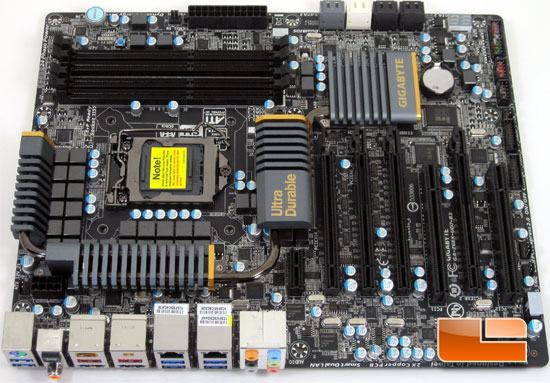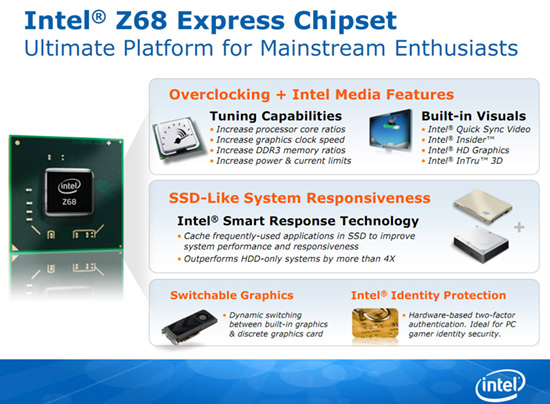GIGABYTE Z68X-UD7-B3 Intel Z68 Motherboard Review
Final Thoughts and Conclusion

If we were to look at strictly the performance of the GIGABYTE Z68X-UD7-B3, I would have no complaints. Unfortunately, I can’t look past what I feel are short comings of the Z68X-UD7-B3. It seems to me, that GIGABYTE took the P67A-UD7-B3 motherboard, slapped the Intel Z68 chipset on it and called it good. The problem with doing that is that it pretty much leaves out the features that separate Intel Z68 chipset from the P67 chipset. You would expect that the boards would be priced close to the same, but that is not the situation that we have here today. We found that the GIGABYTE Z68X-UD7-B3 is currently retailing for $349.99 plus shipping and the GIGABYTE P67A-UD7-B3 is retailing for $314.99 plus shipping though at the time of this writing there is a $20 rebate available making the price only $294.99 plus shipping. That means that there is a $55 price difference between two identical motherboards. What do you get for $55? The only difference between the boards is that the Intel Z68 Express chipset officially supports Intel Smart Response Technology (SRT) for SSD caching. Intel SRT technology works, but why run SSD caching when running the OS on a SSD is faster? By the time you pay $55 more for the Z68 board and then buy an SSD you would have been better off to buy the P67 board and run a cost effective 64GB SSD as the OS boot drive drive.
When the Intel Z68 chipset was first launched, it seemed to meld the H67 chipset with the P67 chipset. The Intel H67 chipset was able to take advantage of the Intel HD Graphics that are available on the second generation of Core iX series processors. In the case of the Intel Core i5 2500K that is used for the Legit Reviews test bench we have the Intel HD Graphics 3000. While the actual graphics capabilities of the Intel HD Graphics are mediocre at best for gaming, they bring with them several technologies that are rather impressive. Among these is the Intel Quick Sync Video which takes video encoding to the hardware level instead of being done through software. We have seen this greatly improve video rendering times with applications that support it. Since the Gigabyte Z68X-UD7-B3 motherboard doesn’t have any video outputs it is unable to use this technology.

Another feature that the Intel Z68 chipset brought to the game was Intel Smart Response Technology. We have looked at this technology a couple of times, first in Joe’s Intel Z68 Chipset & Smart Response Technology as well as Nate’s Intel 311 Larson Creek 20GB SLC SSD Review. Intel’s Smart Response Technology isn’t a bad little feature to add a performance boost down the road if your hard drive is holding your system back. Though you would see an even bigger performance boost from switching to an SSD for your operating system (boot drive). In our own testing today, we saw that it Intel SRT most certainly does give a boost to performance. Though not surprisingly it wouldn’t be as great of a boost as installing a SSD alone.
One of the redeeming factors of the GIGABYTE Z68X-UD7-B3 is it’s overclocking abilities. Perhaps redeeming isn’t the right word. Because the GIGABYTE Z68-UD7-B3 isn’t a bad board, in fact it’s actually a solid board. It just happens to be missing some of the key features that make an Intel Z68 board what it is. During our time overclocking the GIGABYTE Z68X-UD7-B3 we played around with the GIGABYTE Easy Tune 6 software and it was incredibly easy to use. What I liked about the Easy Tune 6 software was the different presets. The level 1 preset is mild boost up to 3.6GHz, level 2 jumps another 200MHz up to 3.8GHz, and level 3 jumps past the 4GHz mark up to 4.1GHz. As we have seen in the past though, all three of these “Auto” overclock settings are quite conservative. To be fair though, I’m sure none of the motherboard manufacturers want to push processors to hard and start blowing up the motherboards or processors. When all was said and done, we were able to hit a solid overclock of 5135MHz! That is just about as high as we have gone on any of the dozen or so Socket 1155 boards that we have looked at!
The GIGABYTE Z68X-UD7-B3 is currently retailing for $349.99 plus shipping, and the GIGABYTE P67A-UD7-B3 is retailing for $314.99 plus shipping though at the time of this writing there is a $20.00 rebate available making the price only $294.99. The only known difference between the two GIGABYTE boards is the Intel Smart Response Technology. By the time you spend an extra $55 on this motherboard and purchase an SSD in order to run SSD caching you would have been better off buying an SSD and using it to install the OS on in the first place. I would recommend the GIGABYTE P67A-UD7-B3 over the Z68X-UD7-B3 strictly due to the cost difference. Though, either way you go, you will be backed by GIGABYTE’s three year limited warranty.
Legit Bottom Line: While the GIGABYTE Z68X-UD7-B3 is a great board in its own respect. You would be better saving a few bucks and getting the GIGABYTE P67A-UD7-B3 and investing it on a larger SSD for your operating system.

Comments are closed.